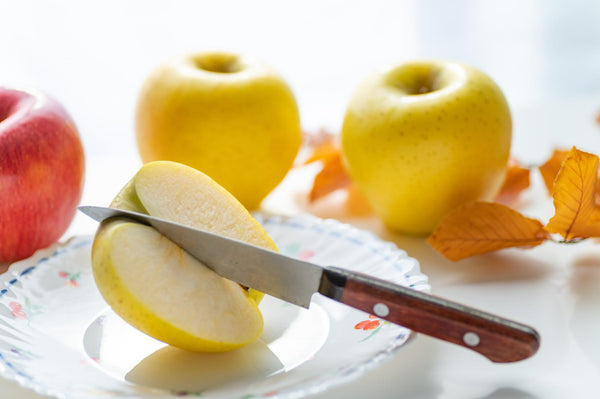The Japanese Petty Knife – Why You Need One In Your Kitchen + 9 Of Our Favorites

Jump to:
Japan is famous for its heavy-duty kitchen knives, such as Gyuto, which are thinner, lighter, and sharper versions of the Western kitchen knife (see this article for a general introduction to Japanese knives). Despite their versatility, however, there are some jobs that the Gyuto cannot perform due to its size, and it is at times like these that the petty knife comes into its own.
In this article, we shall look at the history of the petty knife in Japan, look at its typical features and uses, compare it to similar Japanese knives, and consider what you should look for when choosing one.
History Of The Petty Knife In Japan

There are various theories about the origin of the name “Petty Knife.” Most likely it simply comes from the French word “petit” meaning “small”, although there is also a theory that it combines the words “paring” and “utility”, from paring knife and utility knife, respectively.
Until the Meiji period, eating meat was taboo in Japan. However, meat was eaten more commonly after the Meiji Emperor was seen enjoying it publicly.
As part of this fascination with the West, the Japanese nobility developed a strong fondness for French cuisine, and it is said that the Meiji Emperor frequently served French food at various official government events. At that time, it is said that Japanese people adapted the Petty knife from the Western utility knife, which originally evolved from a French office knife called ‘couteau d’office’.
With the burgeoning popularity of meat due to the growing influence of Western trends in Japan, the petty knife was gradually used more and more for cutting beef, poultry, and pork, and has now firmly established itself as a must-have item in the knife collection of any serious chef.
Now we have looked at how the petty knife came to be used in Japan, let us examine its features and uses in more detail.
Features And Uses Of The Petty Knife

So, what are the characteristics of a petty knife?
The Petty knife usually comes in a large variety of blade sizes, ranging from 80 to 150 mm.
The necessary qualities of a petty knife are that it should be:
1) Small and easy to handle
2) Easy to carry in the hand
3) Light in weight so your hand does not tire easily
4) Be competitive in terms of sharpness with other types of knives
The above qualities of the petty knife make it useful as an all-rounder knife for people who need to operate in smaller workspaces, those with smaller hands, and for those tasks which larger knives would be too unwieldy, such as peeling, slicing, dicing, mincing, and peeling fruits, vegetables, and herbs, as well as smaller cuts of meat and poultry. The largest version of the petty knives can also be used, at a push, for slicing bread.
Petty knife blades tend to be either straight-edged or wavy-edged. Petty knives with straight-edged blades can be used for general peeling of vegetables and fruit, whereas the wavy-edged blade can be used to cut harder items, as well as more delicate foods like tomatoes, which are soft inside but are difficult to peel well. The blades may be made of carbon steel or stainless steel. Carbon steel blades are easier to sharpen and maintain but are more prone to rusting and corrosion and tend to be more expensive. Stainless steel blades tend to be a cheaper alternative but are not as easy to sharpen, and will become dull quickly if not maintained in the correct way. A petty knife should be sharpened using a whetstone <LINK to Whetstone article> or a ceramic sharpener.
Comparison Of The Petty Knife With Other Similar Knives

So how does the petty knife compare to other knives you may find in a Japanese kitchen?
Petty Knife vs Gyuto
The Gyuto (literally “beef knife”), whose blades are between 180 and 270 mm, is, like the petty knife, used for cutting vegetables, meat, and poultry, but being one rank bigger than the petty knife is more suited for cutting larger, bulkier items. Like the petty knife, however, this is probably best suited to boneless meat, and you should be looking at using a cleaver if you want to be able to cut through bone.
Petty Knife vs Paring Knife
While the petty knife is truly multi-functional, the paring knife has a short (approximately 80 mm), durable blade. The paring knife is used almost exclusively for cutting vegetables on a chopping board or peeling items like garlic bulbs in your hands.
Petty Knife vs Santoku
The Santoku (literally “three virtues”) knife is a slightly larger multi-purpose knife than the petty knife, with a blade length of approximately 150-180 mm. The shape of the blade is also different as it only tapers towards the tip at the end of the blade. The three virtues are thought to refer to its ability to cut, crush, and scoop.
As seen from the above, while the petty knife has similarities with various other Japanese knives, it fulfills a role that cannot be carried out by these other knives. So, if you are sold on the idea of getting a petty knife for your knife collection, which one should you go for? That is the subject of the next section.
Our Recommended Japanese Petty Knives
As petty knives vary in terms of a number of factors, including total size, blade/handle size, price, and materials, there is a huge lineup to choose from, depending on what you are looking for. This collection of petty knives on the Japanese Taste website is a great place to start your search.
Best Budget Japanese Petty Knife

As petty knives are made manually by skilled craftspeople, they are never going to be that cheap, but if you are looking to purchase a petty knife on a lower budget, we would recommend this Tojira Fujitoro petty knife, made with stainless steel on the outer layers and cobalt alloy at its core. Despite being less than half the price of many of its competitors, it comes with a variety of features, such as a durable laminated handle to prevent wear, and a convex-edged blade for sharp, smooth cutting.
Best Small Japanese Petty Knife

While petty knives are generally on the small side compared to other types of Japanese knives, some are smaller than others and if you need to operate in smaller spaces, or your hands are on the smaller side, this ultra-sharp and durable Miyabi 5000FC-D Damascus Steel knife, with a beautifully crafted handle and 110 mm blade may be the one for you.
If you are looking for something a little cheaper, this Kiya No. 160 Edelweiss Steel Japanese Petty Knife, although slightly longer, weighs only 70g, and is also easy to operate for smaller hands.
The blade of the Sumikama Kasumi VG10 Steel Fruit Knife at 80 mm blade is smaller than you would normally find with a petty knife but also may be a good option if you want something nimble and lightweight (50 g).
Best Japanese Petty Knife For Larger Hands

If you have larger hands but still want a small blade for manipulating fruits, vegetables, and meat in small spaces, you should definitely check out this Takamura Hamono VG10 Stainless Steel Hammered Petty Knife. While the blade is only 130 mm, its 115 mm handle is longer than many others on the market making it comfortable for larger hands to hold.
Best Knife Set Containing A Japanese Petty Knife

If you are starting your knife collection from scratch and need several different types of knives to use in your kitchen, it may be less hassle, not to mention more economical, to purchase your petty knife as part of a set. This set of five kitchen knives from Yaxell, with stainless steel blades and natural wooden handles is cheaper than some individual petty knives on the market. Depending on the look you are after, this collection of three black titanium-coated knives from Satake may also pique your interest.
If you have a more generous budget, why not take a look at this Yoshikin Global Knife Set, which comes with its own ceramic sharpener? It goes without saying that any of these three knife sets would also make an excellent present or souvenir.
Other Interesting Japanese Petty Knives
If none of the above options are quite what you want, we would also recommend checking out the Takamura Hamono High-Speed Steel Petty Knife, which uses premium high-speed steel (Super Gold) to give the blade both excellent toughness and corrosion resistance and comes in a series also containing Santoku and Gyuto knives.
Also from Takamura is the VG10 stainless steel hammered petty knife, which comes in both 150 mm and 130 mm length versions. Last but not least is this premium petty knife from Misono, that combines high-quality steel with an attractive laminated wood handle.
The Japanese Petty Knife – Where Less Can Be More

The Petty Knife, with its smaller blade and lighter body, can be used for various culinary tasks, such as cutting, peeling, and dicing that require a sharp blade but cannot easily be performed with larger knives, such as the Gyuto and Santoku. There are also times when you are operating within a small space but need something more heavy-duty than a paring knife. In any of the above cases, a petty knife is a must-have member of any knife collection.
Do you use a petty knife? For what tasks do you find it most useful? Please let us know in the comments.

0 comments